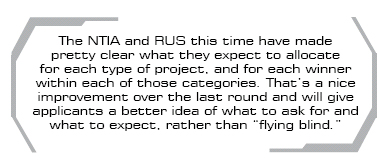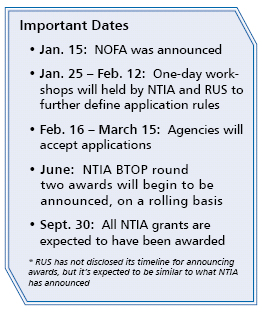Agencies Unveil Rules for Second-Round Broadband Stimulus Program

By Paula Bernier (News - Alert)
The rules for the second round of the broadband
stimulus effort have been released, and they include a lot of good changes.
 That’s because they take steps to expedite a broadband stimulus
effort that has been plagued with delays, and they alter or drop language that many in the industry believed would be a barrier to more widespread and affordable broadband availability
and adoption.
That’s because they take steps to expedite a broadband stimulus
effort that has been plagued with delays, and they alter or drop language that many in the industry believed would be a barrier to more widespread and affordable broadband availability
and adoption.
At the onset of the first round of the broadband stimulus effort, the National Telecommunications and Information Administration
and the Rural Utilities Service together issued just one notice for funds available, or NOFA, document. But this time each of the two agencies issued its own rules.
One thing they have in common is the NTIA and RUS this time have made pretty clear what they expect to allocate for each type of project, and for each winner within each of those categories. That's a nice improvement over the last round and will give applicants a better idea of what to ask for and what to expect, rather than "flying
blind," as Kevin Morgan of ADTRAN (News - Alert) recently put it during a Webinar on the broadband stimulus, referring to the state of affairs during the first round.
The NTIA in round two expects to disperse $2.6 billion overall,
which includes $2.35 billion for comprehensive community infrastructure projects, $100 million for sustainable broadband adoption and $150 million for public computer center initiatives.
The NTIA has disclosed that it expects each winning CCI (News - Alert) application to be in or near the $5 million to $150 million range, and each winning PCC and SBA application to be in the $500,000 to $15 million range.

RUS this round has $2.2 billion to share. That, RUS explains, will include $1.7 billion for last mile projects, $300 million for middle mile projects, $100 million for satellite projects, $5 million
for rural library and technical assistance and $95 million in reserve. The satellite category is a new one for RUS this round, and it is expected that the agency may use the technology to bring broadband to areas for which it doesn't receive any broadband stimulus proposals.
The agencies ask that those seeking broadband
stimulus funds send their applications
to one or the other of them, but not both. That should lessen the review burden on the NTIA and RUS, and thus potentially allow them to move more quickly this time around.
The review process also has been streamlined. RUS says it will go from a two-step to a one-step process, and the NTIA aims to gather all information from applicants up front and will only ask for additional information after that on an as-needed basis.
While grants in the first round had required a 50 percent match from applicants, the government this time around will fund up to 75 percent of a given project, so the applicants need only bring the other 25 percent to the table. That said, those willing to put more skin in the game will be looked upon favorably. A 20 percent match is required for all NTIA applications this round, and those applications
with a 30 percent or greater match will be most favored, according
to the agency.
The cost per premises passed also has been laid out in this round of rules. Any project costing $10,000 or more per premises
passed will not be considered. While that would seem to emphasize the importance of cost-effective infrastructures, some indicate it also could be viewed as a move more favorable to the wireless industry, whose infrastructure can be less expensive
to build but which also tends to offer far less bandwidth. Also, NTIA project proceeds can be applied not only to capital
expenditures, but also to operational expenditures, which could help some projects be more sustainable.
This round the NTIA has made clear its focus on middle-mile projects
and those involving community anchor institutions (and this time the applications involving community anchors don't necessarily
have to be in unserved or underserved areas – a big change). Meanwhile, RUS has indicated it will handle most of the last-mile projects, especially those in which the last-mile component exceeds 20 percent of the total project cost.
The RUS BIP will target areas where not more than 50 percent of locations have more than 5mbps combined upstream/downstream
bandwidth. While projects in areas that are at least 75 percent rural are not required to apply first to BIP, those applicants
that are current RUS borrowers, are proposing projects involving last mile service areas that are 75 percent or more rural, or have a last mile component that exceeds 20 percent of the total eligible project cost, are strongly encouraged to apply to RUS under BIP.
Another significant change to the rules this time around is the removal
of the remote rural language, which many in the industry had lobbied strongly against.
The first-round NOFA defined remote rural areas as those at least 50 miles away from a city or town of at least 20,000, or 50 miles away from an urban area next to a city of at least 50,000 inhabitants. And the first-round NOFA required those seeking funds to build broadband infrastructure in areas defined as remote rural to forward their applications to RUS to be considered for the Broadband Initiatives Program. And if a service provider applicant operates in an area that is defined by the U.S. Census as at least 75 percent rural, the first round NOFA said that company had to go through RUS for broadband funds.
The problem with that was unless the service area was classified as remote rural, the RUS BIP program in its first round limited the grant funds for projects up to 50 percent. And the BIP program in its first round was weighted more heavily toward loans than grants. Meanwhile, the NTIA's Broadband Technology Opportunities Program (BTOP) in its first round provided grant funds for up to 80 percent of project costs for non-rural areas. That meant suburban and urban populations and providers were better positioned to benefit from the broadband stimulus than were those in rural areas – the very locations that most believed the broadband stimulus program was created to serve.
Those interested in watching or commenting on the round two action may also be interested to know that the NTIA expects to post announcements identifying each application received along with a list of the census block groups or tracts that each application proposes to serve through its project, in addition to the information it is required to publicly disclose pursuant to the Recovery Act. That means there will be a greater level of transparency this time as compared to the first round, in which the NTIA only gave the name of the applicants and some other basic information.
NTIA has established a 15-day window during which incumbent
service providers are allowed to comment on applications by prospective broadband stimulus fund winners who want to build broadband networks in their existing service areas. RUS will allow 30 days for comment.
NGN Magazine Table of Contents






 That’s because they take steps to expedite a broadband stimulus
effort that has been plagued with delays, and they alter or drop language that many in the industry believed would be a barrier to more widespread and affordable broadband availability
and adoption.
That’s because they take steps to expedite a broadband stimulus
effort that has been plagued with delays, and they alter or drop language that many in the industry believed would be a barrier to more widespread and affordable broadband availability
and adoption.


